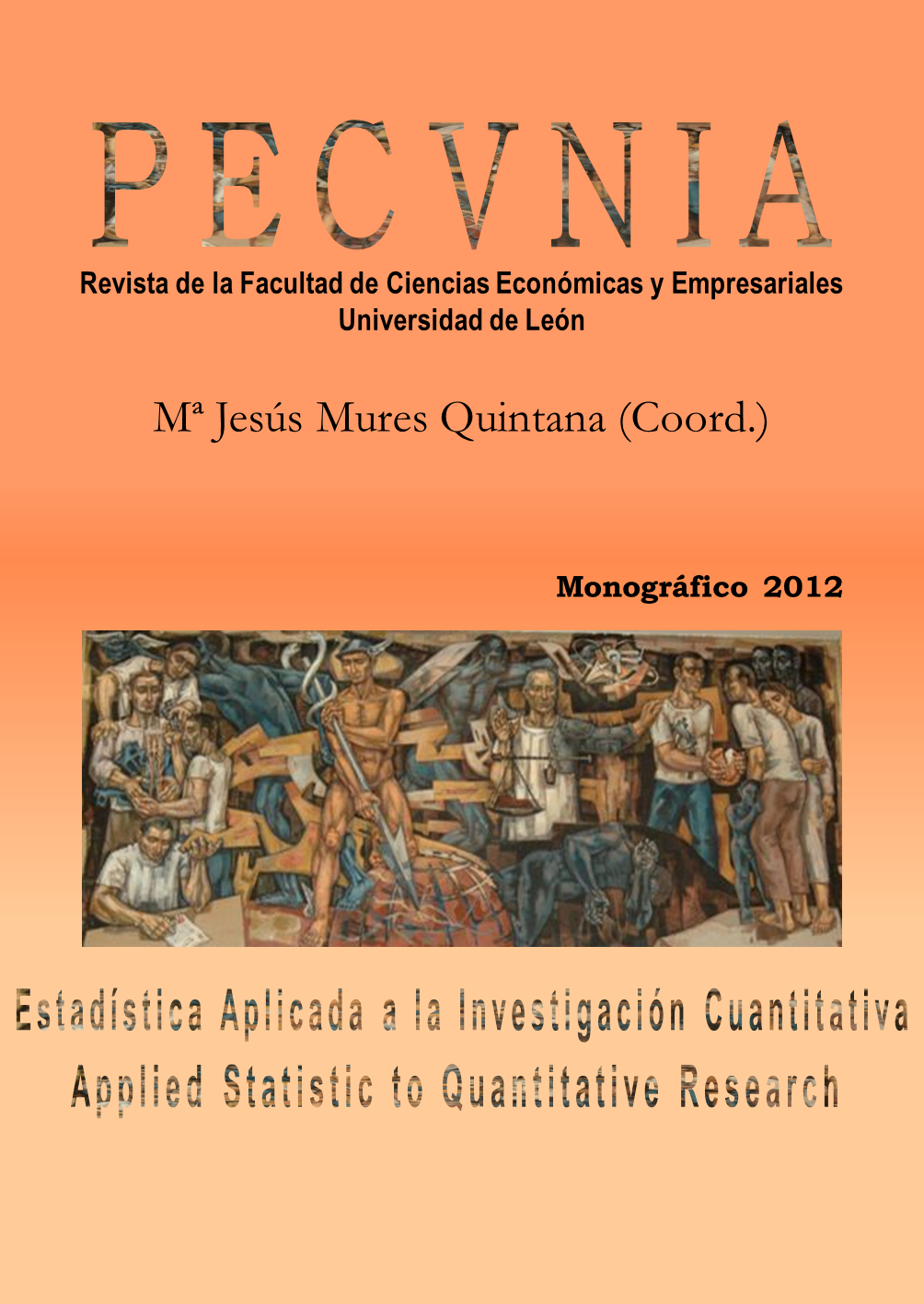Distribución de las transformaciones lineales de los residuos mínimos cuadrados studentizados internamente = Distribution of linear transformations of internally studentized least squares residuals
DOI:
https://doi.org/10.18002/pec.v0i2012.1108Keywords:
Transformación de Borel de residuos Studentizados, Residuos normados, Distribución esférica, Distribución elíptica, Borel transformation of Studentized residuals, Normed residuals, Spherical distribution, Elliptical distribution.Abstract
Los residuos de regresión por mínimos cuadrados ordinarios tienen una distribución que depende de un parámetro escalar. El término “Studentización” se utiliza comúnmente para describir una cantidad U dependiente de un parámetro de escala dividida por una estimación de escala S, de forma que el ratio resultante, U/S, sigue una distribución que no tiene el inconveniente del parámetro de escala desconocido. La Studentización externa hace referencia a un ratio en que el numerador y el denominador son independientes, mientras que la Studentización interna se refiere al ratio en que ambos son dependientes. La ventaja de la Studentización interna es que puede utilizarse cualquier estimador de escala común, mientras que en la Studentización externa, cada residuo es obtenido por un estimador de escala diferente, con el fin de alcanzar la independencia. Con errores de regresión normales, la distribución conjunta de un conjunto arbitrario (linealmente independiente) de residuos Studentizados internamente está bien documentada. Sin embargo, en algunas aplicaciones una combinación lineal de residuos internamente Studentizados puede resultar útil. Sus limitaciones han sido bien documentadas, pero la distribución no parece haberse derivado en la literatura. Este trabajo contribuye a la literatura existente, en el sentido de obtener la distribución conjunta de una transformación arbitraria lineal de residuos de regresión por mínimos cuadrados ordinarios internamente Studentizados con distribución esférica de error. Todas las principales versiones de los residuos de regresión internamente Studentizados que se han utilizado comúnmente en la literatura son casos especiales de la transformación lineal.
Ordinary least squares regression residuals have a distribution that is dependent on a scale parameter. The term 'Studentization' is commonly used to describe a scale parameter dependent quantity U divided by a scale estimate S such that the resulting ratio, U/S, has a distribution that is free of from the nuisance unknown scale parameter. External Studentization refers to a ratio in which the nominator and denominator are independent, while internal Studentization refers to a ratio in which these are dependent. The advantage of the internal Studentization is that typically one can use a single common scale estimator, while in the external Studentization every single residual is scaled by different scale estimator to gain the independence. With normal regression errors the joint distribution of an arbitrary (linearly independent) subset of internally Studentized residuals is well documented. However, in some applications a linear combination of internally Studentized residuals may be useful. The boundedness of them is well documented, but the distribution seems not be derived in the literature. This paper contributes to the existing literature by deriving the joint distribution of an arbitrary linear transformation of internally Studentized residuals from ordinary least squares regression with spherical error distribution. All major versions of commonly utilized internally Studentized regression residuals in literature are obtained as special cases of the linear transformation
Downloads
References
Abrahamse, A.P.J. y Koerts, J. (1971). New estimators in regression analysis. Journal of the American Statistical Association, 66, 71-74.
Anderson, T.W. y Kai-Tai Fang (1990). On the theory of multivariate elliptically contoured distributions and their applications. In T.W. Anderson & Kai-Tai Fang (Eds.), Statistical inference in elliptically contoured and related distributions (pp. 1-23). New York: Allerton Press Inc.
Beckman, R.J. y Trussell, H.J. (1974). The distribution of an arbitrary studentized residual and the effects of updating in multiple regression. Journal of the American Statistical Association, 69, 199-201.
Campbell, C.J. y Wasley, C.E. (1993). Measuring security price performance using NASDAQ returns. Journal of Financial Economics, 33, 73-92.
Campbell, J.Y., Lo, A.W. y Craig MacKinlay, A. (1997). The econometrics of financial markets.
Princeton, NJ: Princeton University Press.
Chatterjee, S. y Hadi, A.S. (1988). Sensitivity analysis in linear regression. New York: Wiley.
Chmielewski, A.K. (1981). Elliptically symmetric distributions: A review and bibliography. International Statistical Review, 49, 67-74.
Corrado, C.J. (1989). A nonparametric test for abnormal security price performance in event studies. Journal of Financial Economics, 23, 385-395.
Cook, D.R. y Weisberg, S. (1982). Residuals and influence in regression. Chapman and Hall.
Díaz-García, J.A. y Gutiérrez-Jáimez, R. (2006). The distribution of the residual from a general elliptical multivariate linear model. Journal of Multivariate Analysis, 97, 1829-1841.
Díaz-García, J.A. y Gutiérrez-Jáimez, R. (2007). The distribution of residuals from a general elliptical linear model. Journal of Statistical Planning and Inference, 137, 2347-2354.
Díaz-García, J.A., Gutiérrez-Jáimez, R. y Alvarado-Castro, V.M. (2007). Exact distributions for sensitivity analysis in linear regression. Applied Mathematical Sciences, 1, 1083-1100.
Eaton, M.L. (1981). On the projections of isotropic distributions. Annals of Statistics, 9, 391-400.
Ellenberg, J.K. (1973). The joint distribution of the standardized least squares residuals from a general linear regression. Journal of the American Statistical Association, 68, 941-943.
Johnston, J. y DiNardo, J. (1997). Econometric methods (4th ed.). Singapore: McGraw-Hill.
Kariya, T. y Eaton, M.L. (1977). Robust tests for spherical symmetry. Annals of Statistics, 5, 206- 215.
Kolari, J. y Pynnönen, S. (2011). Nonparametric rank tests for event studies. Journal of Empirical Finance, 18, 953-971.
Luoma, T. (2011). Nonparametric event study tests for testing cumulative abnormal returns. Acta Wasaensia.
Luoma, T. y Pynnönen, S. (2010). Testing for cumulative abnormal returns in event studies with the rank tests, Working Paper, University of Vaasa (Submitted).
Lloynes, R.M. (1979). A note on Prescott's upper bound for normed residuals. Biometrika, 66, 387- 389.
Margolin, B.H. (1977). The distribution of internally studentized statistics via Laplace transform inversion. Biometrika, 64, 573-582.
Muirhead, R.J. (1982). Aspects of multivariate analysis. New York: Wiley.
Pynnönen, S. (2012). Distribution of an arbitrary linear transformation of internally Studentized residuals of multivariate regression with elliptical errors. Journal of Multivariate Analysis, 107, 40-52.
Stefansky, W. (1972). Rejecting outliers in fractional designs. Technometrics, 14, 469-479.
Downloads
Published
How to Cite
Issue
Section
License
Copyright (c) 2012 Seppo Pynnönem

This work is licensed under a Creative Commons Attribution-NonCommercial-ShareAlike 4.0 International License.
Los autores que publican en esta revista están de acuerdo con los siguientes términos:- Los autores ceden de forma no exclusiva los derechos de explotación (reproducción, distribución, comunicación pública, transformación) a la Universidad de León, por lo que pueden establecer, por separado, acuerdos adicionales para la distribución no exclusiva de la versión de la obra publicada en la revista (por ejemplo, alojarlo en un repositorio institucional o publicarlo en un libro), con un reconocimiento de su publicación inicial en esta revista.
- Este trabajo se encuentra bajo la Creative Commons Attribution-NonCommercial-ShareAlike 4.0 International License. Puede consultarse desde aquí la versión informativa y el texto legal de la licencia.
- Se permite y se anima a los autores a difundir electrónicamente las versiones pre-print (versión antes de ser evaluada) y/o post-print (versión evaluada y aceptada para su publicación) de sus obras antes de su publicación, ya que favorece su circulación y difusión más temprana y con ello un posible aumento en su citación y alcance entre la comunidad académica.












